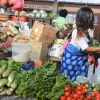As the COVID-19 cases continue to rise across Africa, East Africa is facing another crisis. A second wave of desert locusts is threatening to ruin new crops just a few months after initial swarms hit the region, where more than 20 million people are facing food insecurity.
"The timing is horrendous, because the farmers are just planting, and the seedlings are just coming up now since it's the beginning of the rainy season," says Keith Cressman, the UN’s Food and Agriculture Organisation’s (FAO’s) Senior Locust Forecasting Officer.
The February to May rainy season is the ideal time for farmers to plant crops, with harvesting anticipated from June to early July, which is precisely when the next swarm generation of locusts will be forming. The rains have been good this year, and the damp, humid conditions are perfect for locust eggs to hatch.
The desert locust is considered the most destructive migratory pest in the world. The current outbreak begun with heavy rains from two cyclones in May and October 2018 on the southern Arabian Peninsula. To date the locusts have spread through Djibouti, Ethiopia, Eritrea, Kenya, Tanzania, Uganda, Somalia, South Sudan, Yemen, and over the Persian Gulf.
A single swarm covering one square kilometre contains up to 80 million locusts. FAO estimates the number of locusts could increase another 20 times during this rainy season which could worsen the humanitarian situation.
Restricted movement due to COVID-19 has not made fighting the locusts any easier. FAO is stepping up support to affected countries despite the logistical challenges, working with national governments, farmers and agricultural producers to help contain the outbreak.
"There is no significant slowdown because all the affected countries working with FAO consider desert locusts a national priority," said Cyril Ferrand, FAO's Resilience Team Leader for East Africa, in a statement. He added: "While lockdown is becoming a reality, people engaged in the fight against the upsurge are still allowed to conduct surveillance, and air and ground control operations."
FAO is intensifying remote data collection through a network of partners, civil society, extension workers and grassroot organizations providing information from remote locations especially in Ethiopia, Kenya, Somalia and South Sudan.
The agency is also supporting surveillance efforts as well as aerial and ground spraying across 10 countries. More than 240,000 hectares have been treated with chemical pesticides or biopesticides across the region and 740 people have been trained up to conduct ground locust control operations. But COVID-19 has dented the supply of motorized sprayers and pesticides.
The most efficient method to treat incursions of swarms so far is spraying bio-pesticides in the air using aircraft. The sprays are being sourced from countries like Morocco, the Netherlands, or Japan. However, due to the lockdowns, international integrated supply chains have collapsed, delays and prices increased, and reliability plummeted.
"The biggest challenge we are facing at the moment is the supply of pesticides and we have delays because global air freight has been reduced significantly," Mr. Ferrand said.
He added: "Our absolute priority is to prevent a breakdown in pesticide stocks in each country. That would be dramatic for rural populations whose livelihoods and food security depend on the success of our control campaign."













